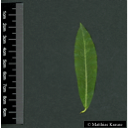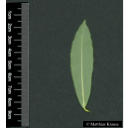Useful information about the taxon (species, subspecies, variety...)
Salix purpurea L. 1753
Salicaceae
(APG IV)purple willow, purpleosier willow
Taxon concept: The Plant List (2014), version 1.1
Distribution: Europe without Scandinavia; the Caucasus, West Siberia, Palestine, northwestern Africa: Algeria, Morocco; introduced into the United States of America
Salix purpurea L. - Accepted: Salix purpurea L. bei The Plant List (2010); Familie: Salicaceae (APG III)Salix purpurea L. - Accepted: Salix purpurea L. bei The Plant List (2010); Familie: Salicaceae (APG IV)Salix purpurea L. - Accepted: Salix purpurea L. bei BfN Checklist Flora DE; Familie: Salicaceae (APG IV)Salix purpurea L. - Accepted: Salix purpurea L. bei World Flora Online - APG IV (Angiosperms); Familie: Salicaceae (World Flora Online - APG IV (Angiosperms))
- Flowers
- dioecious; male and female flowers in slender, pubescent catkins
- Flower ecology
- insect-pollinated (entomophilous)
- Life form
- woody, shrub
- Foliage persistence
- deciduous
- Fruits
- capsule fruit
- Fruit ecology
- wind-dispersed (anemochorous)
- Soil conditions
- on wet, temporarily inundated, nutrient-rich, mostly calcareous, scree, gravel or sand soils, also in mud
- Succession type
- pioneer species on alluvial soils
- Natural occurrence (habitat)
- wetlands, riparian woodlands, river banks, along streams, shores, marshes and fens; from lowland to highland, especially in limestone areas
- Vegetation typ and synecology (plant community)
- temperate, mixed mesophytic broad-leaved deciduous forests; in associations of the Salicetalia purpureae and Berberidion communities
- Usage
- the dried bark is medically used against articular pain and as febrifuge (due to salicin and salicyl acid, respectively); stems are used in basket making; in the USA cultivated as a bionenergy plant
- Altitudinal higher limit (sea level in m)
- 2,500
Erhardt, W., Götz, E., Bödeker, N. & Seybold, S. (2008): Der große Zander. Enzyklopädie der Pflanzennamen. Band 2. Arten und Sorten. Eugen Ulmer KG, Stuttgart (Hohenheim), 18. Aufl., 2103 S.; Haider, M. et al. (2005): Wildbienenkataster. See: https://www.wildbienen-kataster.de; Jäger, E. J. et al. (2007): Rothmaler - Exkursionsflora von Deutschland. Band 5: Krautige Zier- und Nutzpflanzen. Spektrum Akademischer Verlag, Aufl. 31.10.2007: 880.; Ministerium für Ernährung, Landwirtschaft, Umwelt und Forsten, Baden-Württemberg (Hrsg.) (1985): Pflanzenkatalog zur Verbesserung der Bienenweide und des Artenreichtums (Kurztitel: Bienenweidekatalog); Oberdorfer, E. (2001): Pflanzensoziologische Exkursionsflora. Für Deutschland und angrenzende Gebiete. Eugen Ulmer Verlag, Stuttgart, 8., stark überarb. u. erg. Aufl, 1056 S. 978-3-8001-3131-0.; Pritsch, Günter et al. (1985): Bienenweide.. Neumann-Neudamm, Melsungen; Pritsch, Günter et al. (2007): 200 Trachtpflanzen erkennen und bewerten.. Kosmos, Stuttgart; The International Plant Names Index (2009). Published on the Internet http://www.ipni.org; Courtesy to IPNI, 2009. Exported from IPNI at date: 2009-09-22 20:17:51; Westrich, P. et al. (2018): Die Wildbienen Deutschlands.. Ulmer Verlag ISBN 978-8186-0123-2.;
Diese Webseite verwendet Google Maps, um Karten und Standorte von Pflanzen in den Hohenheimer Gärten anzuzeigen. Dadurch werden unter Umständen Daten an Google weitergeleitet, was mit einer Verarbeitung Ihrer personenbezogenen Daten verbunden sein kann. Die Datenschutzerklärung von Google finden Sie hier: Datenschutzerklärung von Google
| Sex | Standort | Accession number | Planting year | Donation | IPEN | Lat. | Long. |
|---|---|---|---|---|---|---|---|
| Parzelle X | LG-X-318-10663 | XX-0-HOH-LG-X-318-10663 | 48,704938 | 9,213672 |


